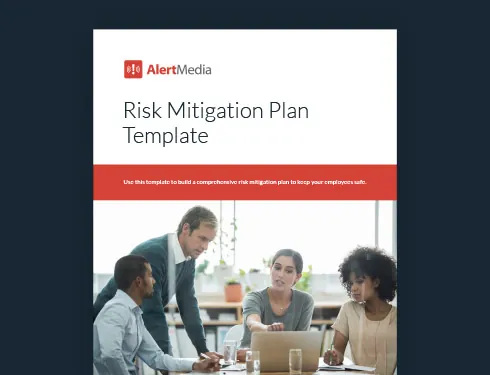Will your teams be ready when the next disruption hits? Use integrated risk management (IRM) to bring clarity, speed, and coordination to every response.

Integrated Risk Management: Turning Strategy Into Action

Disruptions don’t stop to check your org chart. Whether it’s a cybersecurity incident, severe storm, or natural disaster, critical events can affect multiple teams, locations, and business processes—often all at once.
When that happens, your organization needs more than a static plan on paper. You need a risk management strategy that aligns teams around shared priorities, supports clear communication, and helps keep operations running.
That’s where integrated risk management (IRM) comes in.
In this post, we’ll explain IRM and how it differs from traditional risk management processes like enterprise risk management (ERM). We’ll also share a step-by-step roadmap for implementing IRM across your organization to streamline your response during critical events and strengthen business continuity.
Download Our Risk Mitigation Plan Template
What Is Integrated Risk Management?
Integrated risk management is a unified, organization-wide approach to identifying, evaluating, and mitigating risk. Rather than having departments manage risks independently—like IT handling cyber risks or facilities managing physical security—IRM connects these efforts through a common framework. It aligns strategic planning with day-to-day operations, giving teams a shared view of risk and enabling a faster, more coordinated response when incidents occur.
At its core, IRM:
- Breaks down silos so teams can manage risk collaboratively
- Provides a holistic view of threats and vulnerabilities
- Assigns clear ownership to business units and decision-makers
- Supports timely, informed decisions with real-time risk data
IRM goes beyond identifying potential risks—it helps organizations act on them. From workplace safety issues to supply chain disruptions, IRM ensures teams know what to do, who’s responsible, and how to respond. As Gartner explains, “IRM is underpinned by a framework of practices, processes, and enabling technologies that support a risk-aware culture, improved decision-making, and performance.”
Most importantly, IRM makes risk awareness part of everyday work. It’s not a once-a-year compliance activity—it’s built into how teams plan, prioritize, communicate, and make decisions. This integrated approach creates a more resilient organization where risk is managed proactively, not reactively.
IRM vs. ERM (Enterprise Risk Management)
Integrated risk management (IRM) and enterprise risk management (ERM) are both essential pillars of an effective risk strategy, but each has a distinct role in protecting your organization.
Enterprise risk management (ERM) provides the strategic foundation for managing organizational risk. It focuses on identifying threats, assessing their impact, and determining organizational risk tolerance. Typically guided by central teams such as legal, compliance, or senior leadership, ERM provides the high-level insights necessary for proactive risk mitigation and strategic decision-making.
Integrated risk management (IRM) operationalizes this strategy. IRM translates ERM insights into actionable, day-to-day processes, enabling all teams within the organization to respond swiftly and effectively when risks materialize. It ensures clear communication, defined roles, and practical plans tailored to specific scenarios.
For example, ERM might identify a hurricane as a significant strategic risk to a Gulf Coast facility, triggering senior leadership discussions about operational impacts, financial exposures, and organizational preparedness. IRM takes those strategic decisions and translates them into specific, actionable plans: precise communication protocols, contingency staffing arrangements, detailed incident response procedures, and clearly defined roles and responsibilities for team members across functions.
IRM doesn’t replace ERM—it enhances it. Together, they create a unified, resilient framework, ensuring your strategic insights translate effectively into real-world preparedness and response. IRM also serves as a critical link between ERM and governance, risk, and compliance (GRC). While ERM outlines strategic direction and GRC oversees adherence to policies and regulations, IRM ensures the organization responds decisively and effectively when it matters most.
IRM vs. ERM: What’s the real difference? | ||
Category | ERM | IRM |
| Focus | Strategic risks impacting organizational objectives | Operational risks affecting daily business activities |
| Ownership | Central teams (e.g., legal, compliance) | Shared across departments and business units |
| Approach | Top-down analysis and periodic reviews | Continuous integration and coordination across teams and functions |
| Use case | Identifying, assessing, and managing high-level organizational risks | Responding effectively to incidents and disruptions |
| Tools | Risk assessments, scenario analyses, strategic dashboards, and reporting frameworks | Emergency alerts, communication systems, and response protocols |
| Best for | Setting risk appetite, guiding governance, and formulating long-term strategy | Executing plans, coordinating responses, and protecting business continuity |
Why Do Organizations Need Integrated Risk Management?
A decade or two ago, a protest near your headquarters might have meant rerouting foot traffic and monitoring the news. Today, that same event can put employee safety at risk, disrupt supply chains, trigger operational downtime, prompt regulatory reporting, and draw public scrutiny—all in a matter of hours.
The difference isn’t just the threat itself, but how quickly it escalates and how many parts of the business it touches.
From extreme weather and civil unrest to regulatory shifts and system outages, threats are moving faster and hitting harder. Yet many organizations still manage risk in silos. When risk management activities are spread across departments without coordination, responses can be slow and disjointed.
Without IRM, organizations are more likely to face:
- Disconnected or delayed responses
- Communication breakdowns during critical moments
- Conflicting or outdated mitigation plans
- Gaps in regulatory compliance and oversight
An integrated risk management approach solves this by:
- Giving teams real-time visibility into vulnerabilities
- Aligning risk management activities under one strategy
- Standardizing response plans and communication methods
- Clarifying roles and responsibilities before a crisis hits
Core Components and Framework of IRM
IRM gives structure to how your organization anticipates, responds to, and recovers from risk. Here are six core components every IRM strategy should include:
1. Strategy and alignment
Risk management should support your organization’s top priorities, not sit on the sidelines. Aligning your risk strategy with business objectives helps teams focus on what matters most and ensures risk mitigation becomes part of everyday decision-making.
2. Risk assessment and identification
Understanding risk starts with a full view of both internal and external threats. Gathering input across teams and locations builds a clearer understanding of your organization’s risk landscape. Real-time threat intelligence tools like AlertMedia support risk identification and early detection, helping organizations stay ahead of emerging risks.
3. Response planning and execution
An effective response plan outlines clear roles, step-by-step actions, and documented procedures for your most significant risks. Running drills and simulations on a regular basis ensures teams understand their responsibilities and can move quickly when an incident occurs.
4. Communication and reporting
Strong communication is the backbone of effective risk response. Emergency communication platforms like AlertMedia help you reach the right people quickly through multiple channels, so everyone stays informed and aligned.
5. Monitoring and continuous improvement
Every incident, drill, and tabletop exercise is a learning opportunity. Regular reviews and post-incident analyses help refine your response plans over time. As crisis management expert Steven Kuhr explains, “Even in a low-stress environment like a tabletop walkthrough, you’d be surprised how much we learn—and how much we can correct or improve.”
6. Technology and automation
Technology supports integrated risk management by centralizing information, streamlining workflows, and improving team coordination. Automation helps eliminate manual steps, enabling faster alerting and clearer communication. Tools like AlertMedia, for example, provide a single platform to monitor emerging threats, notify impacted employees, and coordinate response activities.
Benefits of Integrated Risk Management
The right IRM strategy does more than minimize risk—it drives business value. By aligning risk efforts across teams, organizations can optimize their response to critical events and protect business continuity.
Here are some of the most significant benefits of adopting an integrated risk management framework:
- Better decisions: Up-to-date risk insights allow leaders to make timely, informed decisions that align with business priorities.
- Simplified compliance: IRM makes it easier to meet regulatory requirements by standardizing reporting and documentation, helping teams stay audit-ready.
- Stronger resilience: IRM helps your organization bounce back faster from unexpected disruptions and maintain continuity.
- More efficient operations: By reducing overlap and simplifying workflows, IRM helps teams accomplish more with fewer resources.
- Improved risk visibility: Centralized risk information gives teams a shared view of risks, their potential impact, and the steps needed to respond effectively.
- Greater stakeholder trust: When your organization responds clearly and consistently, it builds confidence among employees, customers, and partners.
- Clarity around risk appetite: Aligned risk mitigation strategies help define the organization’s willingness to take risks and its risk management plans.
More than a process, IRM is a mindset. It helps build a risk-aware culture by encouraging teams to raise issues early, follow established protocols, and stay prepared for different types of risks.
Common Challenges in Implementing IRM
While the benefits of integrated risk management are clear, putting it into practice isn’t always easy. Building an organization-wide approach to risk often means changing long-standing habits, systems, and working methods.
A few of the most common hurdles teams face include:
- Cultural and organizational resistance: Shifting from siloed processes to shared risk ownership can be uncomfortable, especially for teams used to operating independently.
- Lack of executive sponsorship and cross-functional alignment: IRM initiatives can stall before they start without strong leadership and buy-in across departments.
- Inconsistent data and unclear ownership: Risk management depends on reliable information, but outdated systems and scattered reporting make it hard to get a clear view.
- Technology gaps and integration challenges: When IRM solutions don’t integrate with existing systems, it’s difficult to centralize data and standardize risk workflows.
- Changing regulations and market uncertainty: Frequent shifts in laws and external conditions make it hard to keep risk management activities aligned and up to date.
These challenges are real, but they’re not reasons to avoid IRM. They often signal that your risk processes need more structure and alignment—and that’s exactly what IRM is designed to provide.
Best Practices for Successful IRM Implementation
Implementing IRM requires more than updating policies. It’s about building the right habits, systems, and support to manage risk effectively across teams.
Here’s how to lay a strong foundation:
- Make risk part of everyday work: A risk-aware culture starts with open communication. Encourage teams to raise concerns and speak up when something doesn’t feel right.
- Focus on what matters most: Aligning IRM with business goals and compliance requirements ensures your risk efforts support what’s most critical to your organization.
- Keep plans visible and current: Document, communicate, and regularly update response protocols. A plan no one knows about won’t help in a crisis.
- Train continuously: Tabletop exercises and scenario-based drills help everyone understand their role and build confidence before a real event.
For more ideas on how to move from planning to execution, this interview with crisis leader Steven Kuhr offers a robust framework for building real-world readiness.
How to Build and Implement an IRM Program
A well-built integrated risk management program is structured, phased, and aligned with operational realities. Here’s a step-by-step roadmap for how to create your risk management plan:
- Build the case for IRM: Pinpoint where current risk practices fall short—like misaligned responses or communication delays—and use those gaps to build buy-in for IRM.
- Establish governance and roles: Assemble a cross-functional team to oversee the program and define who’s responsible for risk-related decisions across departments.
- Choose the right technology: Use tools that enable real-time emergency communication and threat intelligence, and are intuitive enough for all teams to use in their daily work.
- Develop and test your framework: Create response protocols for your most critical identified risks and test them regularly to ensure their effectiveness in real-world scenarios.
- Roll out in phases: Begin with the teams or locations facing the most significant risks, so you can fine-tune your approach before scaling it across the organization.
- Monitor, review, and improve: Use metrics, dashboards, and after-action reviews to track performance and improve your risk initiatives over time.
By following these steps, you can build an IRM program that supports a safer, more resilient organization. The goal isn’t perfection—it’s a framework your teams can use, adapt, and rely on when things go wrong. When risk management is part of the day-to-day, your organization is better prepared to handle whatever comes your way.
Future Trends in Integrated Risk Management
Risk is no longer confined to familiar patterns. As threats evolve in scale and complexity, integrated risk management must adapt. That means embracing new technologies, adapting to tighter regulations, and expanding the definition of what counts as risk.
Here are three forces shaping the future of IRM:
Technology is changing risk readiness
AI and digital transformation are reshaping how organizations manage emergencies. Emerging technologies—from predictive analytics to AI assistants for emergency communication—are enabling teams to detect threats earlier and respond faster. With mobile-first tools and cloud-based emergency management systems, IRM is becoming more dynamic, data-driven, and automated.
Compliance is a moving target
Regulations covering data privacy, workplace safety, and duty of care are evolving faster than ever. Compliance can no longer be a once-a-year exercise. IRM programs are adapting to help teams monitor regulatory changes as they happen, revise internal policies accordingly, and maintain clear records to demonstrate compliance, without slowing down daily operations.
ESG risks are now business risks
Environmental, social, and governance (ESG) issues are increasingly tied to operational performance. Climate-related disruptions, labor practices, and ethical sourcing now carry direct financial and reputational consequences. In the U.S., for example, the SEC has proposed rules requiring public companies to disclose climate-related risks. As scrutiny intensifies, IRM is becoming a key tool for identifying ESG-related risks, managing exposure, and demonstrating accountability.
From Plan to Action: Making IRM Work for You
Emergencies don’t happen in silos, and your risk management strategy shouldn’t either. IRM brings together your people, processes, and tools under one coordinated approach to help protect employees and business operations.
Whether you’re facing a natural disaster, security incident, or operational disruption, your response depends on how quickly your teams can communicate, make decisions, and adapt. The stronger your IRM program, the better the outcomes and the faster you regain control.
With a platform like AlertMedia, you can put your IRM framework into practice. Combining real-time emergency communication, threat monitoring, and response coordination in one place helps your teams stay informed and aligned when it matters most. When every team is on the same page, the path from disruption to recovery becomes a whole lot easier to navigate.
Need help getting started? Download the risk management plan template to create and collect risk mitigation plans for a wide range of threats, giving you a single source of truth.





